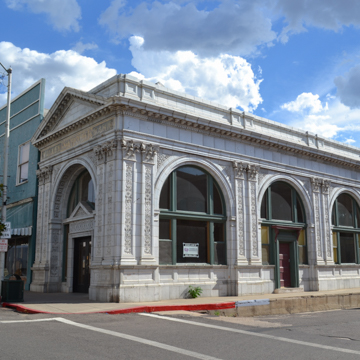Isadore Solomon arrived in Eastern Arizona’s Gila River Valley in 1876. His business pursuits included woodcutting (to supply the copper smelters of Clifton and Morenci), ranching, farming, freighting, and operating a general merchandise store. In 1900, he and a few investors opened the Gila Valley Bank and Trust Company in his store in Solomonville, near present-day Safford, having contracted with the copper companies to make payroll for their employees. They soon opened bank branches in Clifton and Morenci; in 1904, a fourth branch was established in temporary quarters on North Broad Street in Globe.
With the Globe branch soon established as the community’s leading bank, the company purchased a lot at the prominent southwest comer of Broad and Mesquite Streets, where it erected an elaborate new building in 1909. A Chicago architect reportedly designed the 24 x 100-foot building utilizing terra-cotta produced in Chicago. This led to speculation, unsubstantiated, that Louis Sullivan was the designer. Given Globe’s economic prominence at that time, as well as Sullivan’s own professional decline, which led him to accept small commissions in small towns, it was certainly within the realm of possibility—but for the building’s unabashed, and decidedly non-Sullivanesque, classicism. Another possibility is that the bank’s architectural plans could have been purchased from a mail-order catalog, typical of many small but architecturally elaborate banks from the period.
The building was constructed in two distinct segments. The front two-thirds was designed in the Beaux-Arts classical style. White-glazed terra-cotta blocks, ornamented with flowers, vines, olive branches and other decorations, cover the east and north street-facing facades of the reinforced concrete structure. A semicircular arch, supported by pilasters, with elaborately decorated shafts and Corinthian capitals, frames the entry. The inner surface of the arch is ornamented with large acanthus flowers set in blocks; the outer edge with continuous leaf-and-dart molding. The spandrels are ornamented with olive branches. Above the arch is an elaborate entablature and a pediment ornamented with moldings and dentils at the tympanum and supported by scrolled brackets. Brackets with rows of molding and dentils below support the box cornice. Pairs of Corinthian pilasters with elaborate shafts occur at the building corners and between windows. Windows in the main building are large, fixed, semicircles divided into three sections each by mullions.
Inside, the classical details echoed those of the exterior. The south and back walls had large decorated plaster arches. Large ceiling beams were covered with intricate designs in plaster. Three skylights provided natural light from above, while small hexagonal gray and black tiles made distinctive patterns on the floor.
The rear portion of the building housed offices, living quarters for the bank’s trainees, and two large vaults. It was made of fired bricks with string courses between the two stories and below the brick entablature, enriched with brick fretwork. Windows were wooden, one-over-one, double-hung with flat arches at the second story; louvered, metal-frame windows were on the first.
The Gila Valley Bank and Trust Company merged with the Valley Bank of Phoenix in 1922, forming the Valley National Bank. The branch in Globe provided banking services in this location until 1952, when operations were moved into a new building on the northwest corner of Broad and Oak streets. The former bank building became the National News Stand and was subsequently occupied by shifting commercial tenants, including a jewelry store, a bookstore, a gift shop, and a tax service. Partial restoration of the boarded-up north windows and door was done in the mid-1980s. In 1989, an extensive restoration and renovation was undertaken and various retail enterprises have since operated out of the building.
The Gila Valley Bank and Trust Building, a fine example of Beaux-Arts classicism, represents the earliest known use of glazed terra-cotta in Arizona. It was listed on the National Register of Historic Places in 1987.
References
Haak, Wilbur. Globe’s Historic Buildings. Globe, AZ: Gila County Historical Museum, c. 2000.
Hopkins, Ernest Jerome. Financing the Frontier: A Fifty Year History of the Valley National Bank. Phoenix: Valley National Bank, 1950.
Weisiger, Marsha, “Globe Commercial and Civic Multiple Resource Area,” Gila County, Arizona. National Register of Historic Places Inventory Nomination Form, 1987. National Park Service, U.S. Department of the Interior, Washington, D.C.

